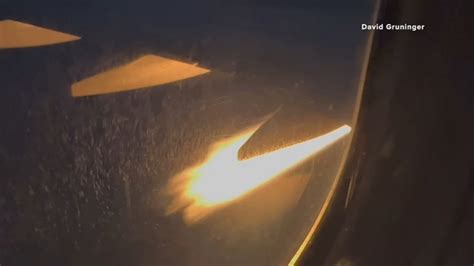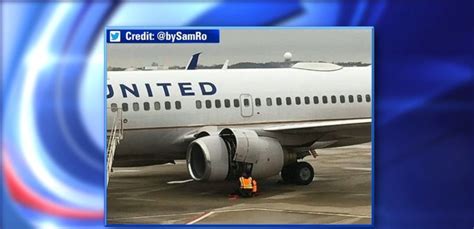
A United Airlines flight traveling from San Francisco to Boston declared an emergency mid-air on Monday due to a reported issue with a flap on one of the wings. United Flight 829, a Boeing 757-200, landed safely at Denver International Airport after diverting from its original route, prompting an immediate response from emergency services. No injuries were reported among the 166 passengers and crew members on board.
The incident unfolded when pilots detected an anomaly with a wing flap, crucial for controlling the aircraft’s lift and stability, particularly during takeoff and landing. According to a statement released by United Airlines, “United Flight 829 from San Francisco to Boston diverted to Denver yesterday evening due to a flap issue. The flight landed safely, and passengers deplaned normally.”
Emergency Declaration and Diversion
As the aircraft climbed to its cruising altitude, the flight crew encountered irregularities with the flap indicator. “Out of an abundance of caution, the pilots decided to divert to Denver,” the United spokesperson stated. Declaring an emergency is a standard procedure that alerts air traffic control and emergency services to prioritize the flight’s landing, ensuring a swift response in case the situation escalates. The specific distress code used was not disclosed in the initial reports, but it is understood that the declaration prompted immediate coordination between the flight crew, air traffic controllers, and ground support teams.
The decision to divert to Denver was strategic due to the airport’s capacity to handle large aircraft and the availability of maintenance facilities. Denver International Airport (DIA) is a major hub with extensive resources for aircraft maintenance and emergency services, making it an ideal location for such diversions.
Safe Landing and Passenger Handling
Upon landing at Denver International Airport, the aircraft was met by emergency response teams, including firefighters and medical personnel, as a precautionary measure. Passengers deplaned normally and were taken to the terminal, where United Airlines personnel provided assistance and information. The airline worked to rebook passengers on alternative flights to Boston, minimizing further disruption to their travel plans.
“We are working to get them on their way as soon as possible,” the United spokesperson added. The rebooking process involved coordinating with other airlines and utilizing available seats on subsequent United flights. Passengers were also offered accommodations and meal vouchers to compensate for the inconvenience caused by the delay.
Aircraft Inspection and Maintenance
Following the safe landing, the Boeing 757-200 was taken to a maintenance hangar for a thorough inspection. Aircraft maintenance technicians began a comprehensive assessment of the wing flaps and associated systems to determine the root cause of the reported issue. The inspection process includes visual checks, functional tests, and detailed diagnostics to identify any mechanical or electrical faults.
The wing flaps are critical components of an aircraft’s flight control system. They are used to increase the wing’s surface area and change its shape, providing additional lift at lower speeds. This is particularly important during takeoff and landing, where the aircraft needs to maintain sufficient lift while flying at reduced speeds. A malfunctioning flap can affect the aircraft’s handling characteristics and potentially compromise safety.
United Airlines maintains a rigorous maintenance program for its fleet, adhering to strict guidelines set by the Federal Aviation Administration (FAA). Regular inspections and maintenance checks are performed to ensure that all aircraft systems are functioning correctly and that any potential issues are identified and addressed promptly.
Boeing 757-200: A Reliable Workhorse
The Boeing 757-200 is a narrow-body airliner that has been a workhorse for airlines around the world for decades. Known for its versatility and efficiency, the 757-200 is capable of operating on both short- and long-haul routes. It has a proven track record of safety and reliability, making it a popular choice for airlines.
The 757-200 is equipped with two powerful engines and advanced flight control systems. It can carry up to 289 passengers in a single-class configuration or a smaller number in a two-class configuration. The aircraft’s range is approximately 3,900 nautical miles, allowing it to fly non-stop between many major cities.
Despite its age, the 757-200 remains in service with numerous airlines, including United Airlines. These aircraft undergo regular maintenance and upgrades to ensure they meet current safety standards and operational requirements.
Expert Opinions and Analysis
Aviation experts have weighed in on the incident, emphasizing the importance of the crew’s decision to declare an emergency and divert the flight. “The pilots made the right call,” said John Cox, a retired airline captain and aviation safety consultant. “When you have an issue with a critical flight control surface like a wing flap, it’s always best to err on the side of caution and land the aircraft as soon as possible.”
Cox added that the safe landing at Denver International Airport demonstrated the effectiveness of the airline’s safety procedures and the professionalism of the flight crew. “This incident highlights the importance of ongoing training and adherence to standard operating procedures,” he said.
Other aviation experts noted that incidents involving wing flaps are relatively rare but can pose a significant challenge to pilots. “Wing flaps are complex mechanical systems, and they can sometimes malfunction due to mechanical failure or electrical issues,” said Robert Mark, an aviation analyst. “Pilots are trained to handle these types of emergencies, and they have procedures in place to safely land the aircraft even if one or more flaps are not functioning correctly.”
Impact on Passengers and Travel Plans
The diversion of United Flight 829 caused significant disruption to the travel plans of the 166 passengers on board. Many passengers missed connecting flights and had to spend an unexpected night in Denver. United Airlines provided accommodations and meal vouchers to affected passengers, but the inconvenience was still considerable.
“I was supposed to be in Boston for a business meeting this morning,” said one passenger. “Now I’m stuck in Denver, and I don’t know when I’ll be able to get there. It’s very frustrating.”
Other passengers expressed relief that the flight landed safely and praised the professionalism of the flight crew. “I was a little nervous when the pilot announced that we were diverting to Denver due to a mechanical issue,” said another passenger. “But the crew kept us informed throughout the process, and they did a great job of landing the plane safely.”
Historical Context of Similar Incidents
While incidents involving wing flaps are not common, there have been other similar cases in the past that have highlighted the importance of safety procedures and crew training. In 2015, a British Airways flight from London to Hong Kong had to make an emergency landing in Siberia after a flap malfunctioned. The aircraft landed safely, and there were no injuries.
In 2018, a Delta Air Lines flight from Atlanta to Amsterdam experienced a flap issue shortly after takeoff. The pilots declared an emergency and returned to Atlanta, where the aircraft landed safely.
These incidents underscore the fact that even with advanced technology and rigorous maintenance programs, mechanical failures can still occur. However, the aviation industry has learned from these incidents and implemented measures to prevent them from happening again.
The Role of the Federal Aviation Administration (FAA)
The Federal Aviation Administration (FAA) plays a critical role in ensuring the safety of air travel in the United States. The FAA sets standards for aircraft maintenance, pilot training, and air traffic control. It also investigates accidents and incidents to determine their causes and prevent them from happening again.
Following the incident involving United Flight 829, the FAA is likely to review the circumstances surrounding the flap malfunction and determine whether any regulatory changes are needed. The FAA may also work with Boeing and United Airlines to identify any potential design flaws or maintenance issues that could have contributed to the incident.
Future Implications for United Airlines
The incident involving United Flight 829 could have implications for United Airlines’ operations and reputation. The airline will need to address the root cause of the flap malfunction and take steps to prevent similar incidents from happening in the future. This may involve additional training for maintenance personnel or modifications to the aircraft’s maintenance program.
United Airlines will also need to manage the public relations fallout from the incident. The airline will need to communicate effectively with passengers and the public to reassure them that it is taking all necessary steps to ensure the safety of its flights.
Technological Advancements in Aviation Safety
The aviation industry is constantly evolving, with new technologies being developed to improve safety and efficiency. One area of focus is the development of more reliable and robust flight control systems.
Newer aircraft models are equipped with advanced fly-by-wire systems that use computers to control the aircraft’s flight surfaces. These systems can automatically compensate for malfunctions and provide pilots with additional assistance in handling emergencies.
Another area of focus is the development of more sophisticated diagnostic tools that can detect potential problems before they lead to mechanical failures. These tools can monitor the performance of aircraft systems and alert maintenance personnel to any anomalies.
The Importance of Crew Resource Management (CRM)
Crew Resource Management (CRM) is a critical component of aviation safety. CRM is a training program that teaches flight crews how to work together effectively and communicate clearly in emergency situations.
CRM training emphasizes the importance of teamwork, leadership, and decision-making. It also teaches flight crews how to recognize and manage stress, fatigue, and other factors that can affect their performance.
The crew of United Flight 829 demonstrated the principles of CRM by working together effectively to diagnose the flap issue, declare an emergency, and land the aircraft safely.
Broader Impact on the Aviation Industry
The incident involving United Flight 829 serves as a reminder of the importance of safety in the aviation industry. The industry has a strong track record of safety, but it is constantly striving to improve its performance.
Incidents like this one provide valuable lessons that can be used to enhance safety procedures and prevent future accidents. The aviation industry is committed to learning from its mistakes and continuously improving its safety record.
Passenger Perspectives and Experiences
Passengers on United Flight 829 experienced a range of emotions, from anxiety and fear to relief and gratitude. Many passengers praised the flight crew for their professionalism and communication skills.
“The pilots kept us informed every step of the way,” said one passenger. “They explained what was happening and what we could expect. It really helped to calm our nerves.”
Other passengers expressed frustration with the delays and inconvenience caused by the diversion. However, most passengers acknowledged that safety was the top priority.
Future of Air Travel Safety
The future of air travel safety is likely to be shaped by technological advancements, enhanced training programs, and a continued focus on safety management systems.
New technologies, such as artificial intelligence and machine learning, could be used to predict and prevent mechanical failures. Enhanced training programs could focus on developing pilots’ skills in handling emergencies and managing stress. Safety management systems could be used to identify and mitigate potential risks before they lead to accidents.
The aviation industry is committed to making air travel as safe as possible. By learning from past incidents and embracing new technologies, the industry can continue to improve its safety record.
Weather Conditions and Their Impact
Although not cited as a direct cause, weather conditions can play a significant role in aviation safety and decision-making. While the Yahoo News article does not mention the weather, it’s conceivable that turbulence or other weather-related factors could have exacerbated the perceived flap issue, leading to the emergency declaration. Airlines closely monitor weather forecasts and real-time conditions to ensure safe flight operations. Pilots are trained to navigate various weather scenarios and make informed decisions based on the prevailing conditions.
Communication Protocols During Emergencies
Effective communication is paramount during in-flight emergencies. The pilots of United Flight 829 likely followed strict communication protocols, including contacting air traffic control, informing passengers of the situation, and coordinating with ground support teams. Clear and concise communication ensures that all stakeholders are aware of the situation and can take appropriate actions. The use of standardized terminology and procedures helps to minimize confusion and ensure that critical information is relayed accurately and efficiently.
The Importance of Routine Maintenance Checks
Airlines conduct routine maintenance checks on their aircraft to identify and address potential issues before they become safety hazards. These checks involve inspecting various aircraft components, including the engines, flight control systems, and landing gear. Maintenance personnel follow detailed procedures and use specialized equipment to ensure that all systems are functioning correctly. The frequency of maintenance checks is determined by regulatory requirements and the manufacturer’s recommendations. Regular maintenance helps to maintain the airworthiness of aircraft and prevent accidents.
Psychological Impact on Passengers and Crew
In-flight emergencies can have a significant psychological impact on passengers and crew members. Passengers may experience fear, anxiety, and stress. Crew members may face the pressure of managing the situation and ensuring the safety of everyone on board. Airlines often provide counseling and support services to help passengers and crew members cope with the emotional aftermath of such events. Debriefing sessions can also be conducted to review the incident and identify lessons learned.
The Role of Air Traffic Control (ATC)
Air traffic control plays a crucial role in managing air traffic and ensuring the safety of flights. ATC controllers monitor aircraft movements, provide guidance to pilots, and coordinate emergency responses. In the case of United Flight 829, ATC controllers likely worked closely with the pilots to facilitate the diversion to Denver International Airport. They would have cleared airspace, coordinated with emergency services, and provided the pilots with real-time information about weather conditions and airport procedures.
FAQ Section
1. What caused United Flight 829 to declare an emergency?
United Flight 829 declared an emergency due to a reported issue with a flap on one of the wings. According to United Airlines, the flight diverted “due to a flap issue.”
2. Where did the flight divert to, and why?
The flight diverted to Denver International Airport. Denver was chosen because it is a major hub with extensive resources for aircraft maintenance and emergency services, making it an ideal location for such diversions.
3. Were there any injuries reported?
No, there were no injuries reported among the 166 passengers and crew members on board. The flight landed safely, and passengers deplaned normally.
4. What happened to the passengers after the flight landed in Denver?
Passengers were taken to the terminal, where United Airlines personnel provided assistance and information. The airline worked to rebook passengers on alternative flights to Boston and offered accommodations and meal vouchers to compensate for the inconvenience.
5. What type of aircraft was involved in the incident?
The aircraft involved was a Boeing 757-200. This is a narrow-body airliner known for its versatility and efficiency, commonly used for both short- and long-haul routes.









